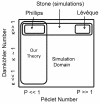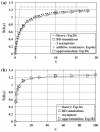Singular perturbation theory for predicting extravasation of Brownian particles
- PMID: 24563548
- PMCID: PMC3927922
- DOI: 10.1007/s10665-013-9665-2
Singular perturbation theory for predicting extravasation of Brownian particles
Abstract
Motivated by recent studies on tumor treatments using the drug delivery of nanoparticles, we provide a singular perturbation theory and perform Brownian dynamics simulations to quantify the extravasation rate of Brownian particles in a shear flow over a circular pore with a lumped mass transfer resistance. The analytic theory we present is an expansion in the limit of a vanishing Péclet number (P), which is the ratio of convective fluxes to diffusive fluxes on the length scale of the pore. We state the concentration of particles near the pore and the extravasation rate (Sherwood number) to O(P1/2). This model improves upon previous studies because the results are valid for all values of the particle mass transfer coefficient across the pore, as modeled by the Damköhler number (κ), which is the ratio of the reaction rate to the diffusive mass transfer rate at the boundary. Previous studies focused on the adsorption-dominated regime (i.e., κ → ∞). Specifically, our work provides a theoretical basis and an interpolation-based approximate method for calculating the Sherwood number (a measure of the extravasation rate) for the case of finite resistance [κ ~ O(1)] at small Péclet numbers, which are physiologically important in the extravasation of nanoparticles. We compare the predictions of our theory and an approximate method to Brownian dynamics simulations with reflection-reaction boundary conditions as modeled by κ. They are found to agree well at small P and for the κ ≪ 1 and κ ≫ 1 asymptotic limits representing the diffusion-dominated and adsorption-dominated regimes, respectively. Although this model neglects the finite size effects of the particles, it provides an important first step toward understanding the physics of extravasation in the tumor vasculature.
Keywords: Brownian dynamics; Extravasation; Law of additive resistances; Singular perturbation.
Figures










Similar articles
-
Extravasation of Brownian Spheroidal Nanoparticles through Vascular Pores.Biophys J. 2018 Sep 18;115(6):1103-1115. doi: 10.1016/j.bpj.2018.07.038. Epub 2018 Aug 17. Biophys J. 2018. PMID: 30201266 Free PMC article.
-
Brownian dynamics simulations of coagulation of dilute uniform and anisotropic particles under shear flow spanning low to high Peclet numbers.J Chem Phys. 2015 Jan 14;142(2):024108. doi: 10.1063/1.4905098. J Chem Phys. 2015. PMID: 25591339
-
Brownian Particle Adsorption in Unsteady-State Viscous Flows in Pores.J Colloid Interface Sci. 1997 Feb 15;186(2):477-92. doi: 10.1006/jcis.1996.4669. J Colloid Interface Sci. 1997. PMID: 9056378
-
Transport of nanoparticles in magnetic targeting: Comparison of magnetic, diffusive and convective forces and fluxes in the microvasculature, through vascular pores and across the interstitium.Microvasc Res. 2020 Jul;130:104007. doi: 10.1016/j.mvr.2020.104007. Epub 2020 Apr 17. Microvasc Res. 2020. PMID: 32305349
-
Pore-scale modeling of competitive adsorption in porous media.J Contam Hydrol. 2011 Mar 1;120-121:56-78. doi: 10.1016/j.jconhyd.2010.06.008. Epub 2010 Jun 30. J Contam Hydrol. 2011. PMID: 20691495
Cited by
-
Extravasation of Brownian Spheroidal Nanoparticles through Vascular Pores.Biophys J. 2018 Sep 18;115(6):1103-1115. doi: 10.1016/j.bpj.2018.07.038. Epub 2018 Aug 17. Biophys J. 2018. PMID: 30201266 Free PMC article.
References
-
- Zhao H, Shaqfeh ESG, Narsimhan V. Shear-induced particle migration and margination in a cellular suspension. Phys Fluids. 2012;24:011902.
-
- Zhao H, Shaqfeh ESG. Shear-induced platelet margination in a microchannel. Phys Rev E. 2011;83:061924. - PubMed
-
- Heldin CH, Rubin K, Pietras K, Östman A. High interstitial fluid pressure: an obstacel in cancer therapy. Nat Rev Cancer. 2004;4:806–813. - PubMed
-
- Stroher M, Boucher Y, Stangassinger M, Jain RK. Oncotic pressure in solid tumors is elevated. Cancer Res. 2000;60:4251–4255. - PubMed
Grants and funding
LinkOut - more resources
Full Text Sources
Other Literature Sources
